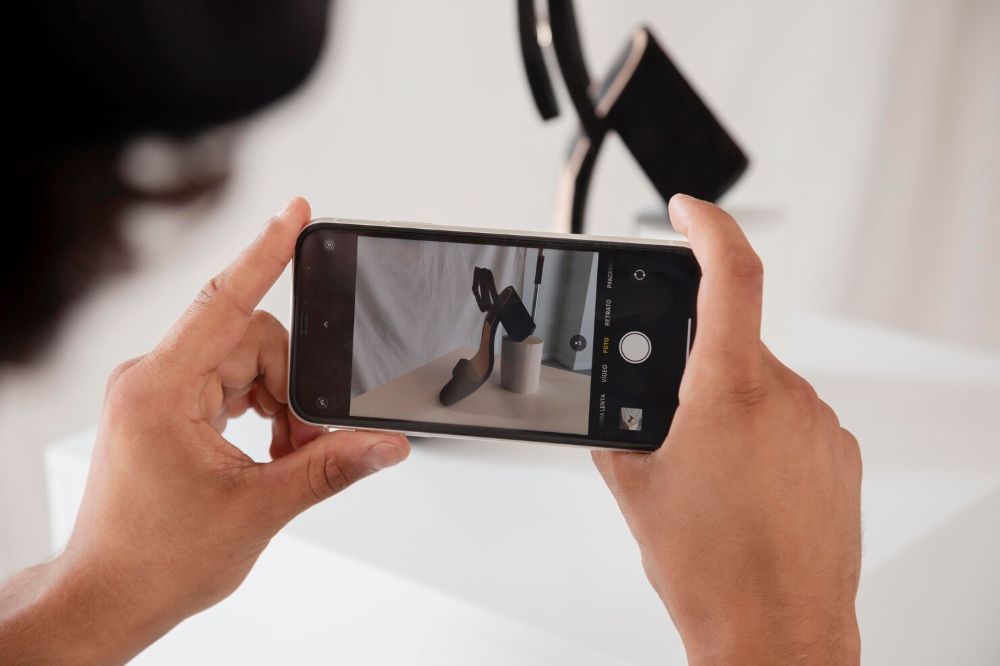Nowadays, it’s easy to rely on smartphones for almost everything, including photography. But when it comes to capturing truly professional-quality images representing your brand, you might be left wondering if your iPhone can compete with a dedicated camera.
In the age of ever-improving smartphone cameras, it’s also tempting to think that professional cameras are a thing of the past. But is that really the case?
Why High-Quality Photos Are Crucial for Your Brand
When you’re scrolling through social media or browsing a website, what catches your eye first? It’s usually the images.
In today’s visually-driven world, high-quality photos are essential to make a lasting impression. And being the first thing that potential customers see, photos also become crucial elements that shape your brand identity and image.
Besides, high-quality photos can convey your brand’s personality, values, and key messages more effectively than text alone. They can also help build trust and credibility with your audience. In a crowded marketplace, photos taken by a professional photography studio can be the key to differentiating your brand and capturing attention.
1. Image Quality: A Key Differentiator
When it comes to image quality, professional cameras and iPhones each has their strengths and weaknesses. For instance, professional cameras generally have larger sensors compared to iPhones, capturing more light and detail. This translates to superior image quality, especially in low-light scenarios, allowing for greater dynamic range and less noise in your photos.
Furthermore, the advantage of interchangeable lenses on professional cameras allows you to choose the best lens for the job and achieve different effects and perspectives. Whether you need a wide-angle lens for landscapes and real estate photography or a macro lens for close-ups, professional cameras offer unparalleled versatility.
And let’s not forget the sophisticated image processing capabilities of professional cameras, which optimise images for sharpness, colour accuracy, and noise reduction, ensuring your photos look their best, even in challenging shooting conditions.
iPhones, on the other hand, leverage computational photography to enhance image quality through software algorithms, which include features like HDR, portrait mode, and night mode. Plus, the multiple lenses featured on many iPhone models offer versatility in capturing different types of shots, including wide-angle, telephoto, and macro capabilities, expanding your creative possibilities.
While iPhones might not match the overall image quality of professional cameras, they can still produce excellent photos in well-lit conditions. Besides, their convenience and computational photography are great features that you can use for everyday photography.
2. Manual Control and Flexibility: Customisation vs. Simplicity
Professional cameras and iPhones also offer different levels of control over your photography experience. Professional cameras, for instance, provide extensive manual controls, empowering photographers to fine-tune settings for creative expression.
Additionally, you can adjust the aperture to control depth of field, shutter speed to capture or blur motion, and ISO to manage sensitivity to light. What’s more, different focusing modes allow for precise control over what’s in focus, ensuring sharp images in various situations.
iPhones, on the other hand, prioritise simplicity and ease of use, and their intuitive interface and automatic modes make photography accessible to everyone. AI algorithms also optimise settings for various scenes, ensuring good results with minimal effort. While iPhones offer some manual controls and customisation options, their strength lies in their ability to capture great photos effortlessly.
3. Convenience and Portability: Always Ready vs. Planned Shoots
When it comes to convenience, the iPhone is the clear winner. It’s always with you, ready to capture spontaneous moments and everyday adventures. Plus, its portability makes it perfect for travel and casual photography.
Professional cameras, while offering higher image quality and control, are bulkier and heavier, especially with lenses and accessories. They’re better suited for planned product, corporate, and lifestyle photoshoots where you have time to set up and compose your shots.
However, if you want a balance between quality and convenience, mirrorless cameras can be a great choice. While they’re smaller than DSLRs, they can still take professional-grade pictures.
4. Editing and Sharing: RAW Power vs. Instant Gratification
Professional cameras and iPhones offer different approaches to editing and sharing your photos. For example, with a professional camera, you can shoot in RAW format, allowing you to preserve more image data which can be a foundation for extensive editing flexibility. What’s more, professional editing software like Adobe Lightroom or Photoshop provides advanced tools for fine-tuning every aspect of the photos.
iPhones, as mentioned, prioritise convenience and ease of use. Their built-in editing tools and user-friendly apps make it easy to enhance photos on the go. Sharing is also seamless, with quick access to social media and instant messaging platforms.
Capturing Your Vision: The Power of Professional Photography

While iPhones have made significant strides in photography, when it comes to creating truly impactful photos that elevate your brand and drive results, professional photography remains the gold standard. A professional photographer brings a wealth of experience, technical expertise, and creative vision to every shoot, ensuring your photos capture attention and tell your brand story effectively.
Whether you’re looking to capture corporate headshots or showcase your products in their best light, working with a professional photography studio in Singapore is an investment in your brand’s success.
Contact J Studio today to discuss your photography needs and discover how our team of experts can help you create images that make a lasting impression.


Leave a reply